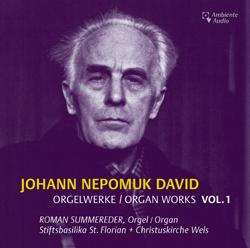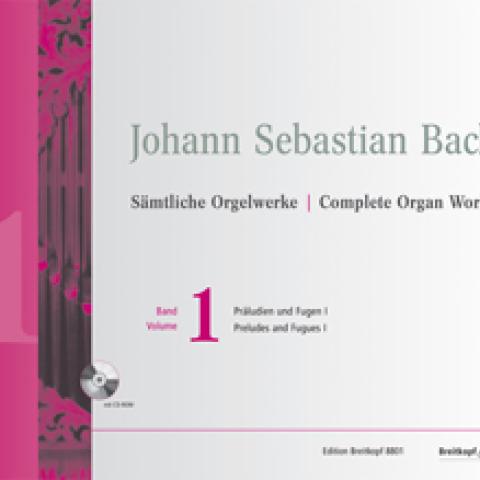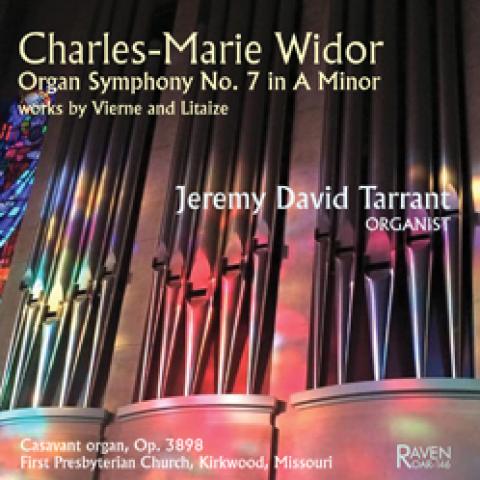In 2014 there are several composers whose anniversaries can be commemorated, albeit some of the dates are not known for certain. Some of the names need no introduction but there are also several lesser-known names listed here whose compositions are well worth exploring. No claim is made for completeness, and there is no guarantee that every edition is in print—there may well also be editions by other publishers.
Giaches Brumel (ca. 1510–64).French composer who worked at the court in Ferrara from 1532. Ascribed to Brumel are two ricercars (one imitative and one chordal) and a Missa de la Dominica in the manuscripts at Castell Arquato, edited by Knud Jeppesen for Norsk Musikforlag, Oslo, in Die italienische Orgelmusik am Anfang des Cinquecento and more recently, albeit in halved note values, by H. Colin Slim for American Institute of Musicology Corpus of Early Keyboard Music 37, volume 3, which contains a wider selection from the manuscripts. It has been postulated that 14 of the set of 17 ricercars known as the Bourdeney Codex may also be by Brumel. These lengthy contrapuntal works have been edited by Anthony Newcomb for A–R Editions (R89).
Francisco de Peraza (1564–98).Organist in Seville, he left a Medio Registro alto de 1 Tono, the earliest known surviving example of this genre, which became popular in the Iberian repertoire. This has appeared in several anthologies, including American Institute of Musicology’s Corpus of Early Keyboard Music 14: Spanish Organ Music after Antonio de Cabezon, edited by Willi Apel.
Gregor Aichinger (1564–1628).Organist in Augsburg to the Fuggers, six ricercars and four motet intabulations have been edited by Eberhard Kraus in Cantantibus organis, vol. 7, for Verlag Friedrich Pustet. A further motet intabulation is included in Altbaierische Orgelmusik, vol. 1, edited by Eberhard Kraus for Noetzel.
Giovanni de Macque (ca. 1550–1614). Born in Flanders, he came to Naples ca. 1585, becoming head of the vice-regal chapel in 1599. He was the teacher of Ascanio Mayone and Giovanni Maria Trabaci, both of whom published two volumes of highly influential pieces. De Macque published copious amounts of madrigals but no keyboard works; however, almost 40 pieces survive in manuscripts. These include eight canzonas, four capriccios, two stravaganzes, a consonanze stravaganti, a durezze e ligature, an intrata, a toccata a modo di Trombetta and a set of variations on Ruggiero, which have been edited by Liuwe Tamminga (vol. 1), and 14 ricercars (the first book of 12 published ricercars set for keyboard together with a further two thought to be from the second book), edited by Armando Carideo (vol. 2); both volumes are published by Il Levante (available through La Stanza della Musica). The first set of 12 ricercars has also been edited by Christopher Stembridge for Zanibon. This edition includes a comprehensive discussion of the modes and their affects, along with the registration prescribed by Diruta. The ricercars are the first to present the different subjects at the beginning of the piece. The durezze and stravaganze are highly chromatic compositions. The older edition by Watelet and Piscaer for Monumenta Musica Belgae also contains Partite sopra Zefiro de Rinaldo attributed by the editor to de Macque; this, however, is almost certainly a set of partite on Zefiro composed by Rinaldo dell’Arpa.
Hans Leo Hassler (1564–1612). Primarily known today for his vocal music, he studied organ in Venice with Andrea Gabrieli and became a leading player in Augsburg. He left a substantial corpus of keyboard works of considerable scope and length, most of it preserved in the Turin manuscripts, including eight toccatas, 18 ricercari, 18 canzone, fourteen Magnificats, an organ Mass, four fugues, and two sets of variations. Problems of attribution have occurred with pieces variously ascribed to Sweelinck, Christian Erbach, and Giovanni Gabrieli. A good selection, as well as the variations on Ich ging einmal spazieren, was edited by Georges Kiss for Schott and Sons. The toccatas were edited by S. Stribos for the American Institute of Musicology, and the Magnificats by A. Carpene for Il Levante Libreria. A few other pieces from other manuscript sources have been included in various anthologies, including 25 of the 39 intabulated songs from his Lustgarten of 1601, edited by M. Böcker for Breitkopf & Härtel. The complete works from the Turin manuscripts are available in two volumes, edited by W. Thein and U. Wethmüller for Breitkopf & Härtel. A further volume containing the complete remaining keyboard works from other sources has been in preparation for some time. These supersede the edition of a small selection of pieces by Hassler and Erbach, edited by Ernst von Werra ca. 1903 for Denkmäler der Tonkunst in Bayern, second series, vol. IV, no. 2.
Franz Tunder (1614–67). Organist of the Marienkirche, Lübeck, he left about 17 compositions in manuscripts, including five praeludia exemplifying early use of the Stylus Phantasticus and a canzona, along with 11 chorale settings, of which six are fantasias. Auf meinen lieben Gott is set for two manuals without pedal, Jesus Christus, wahr Gottes Sohn is for single manual and pedals, and Jesus Christus, unser Heiland has three separate variations, of which the first includes much use of double pedal. Two further chorale settings in the Pelpin manuscripts originally attributed to Scheidemann have now been tentatively attributed to Tunder. All pieces have been edited by Klaus Beckmann for Breitkopf & Härtel.
Benjamin Rogers (1614–98). Organist at Eton and Oxford, he left sacred and secular vocal music, consort music, and 17 keyboard works of which the great majority are dances better suited to stringed keyboard instruments. Two, however, are voluntaries and are more suited to performance on the organ. All pieces have been edited by Richard Rastall for Stainer & Bell.
Charles Racquet (1597–1664). Organist in Paris, he left 12 versets de psaume en duo, which was printed in Mersenne’s Harmonie universelle, Paris, 1636–37, and a large–scale Fantasie in manuscript. All have been edited along with works by De Bourges, N. de la Grotte, and D. Gaultier by Jean Bonfils in L’Organiste Liturgique, xxix–xxx for Schola Cantorum et de la Procure générale de musique.
Georg Leyding (1664–1710). He had lessons with Buxtehude and became organist in Brunswick. Although Walther mentions his many keyboard pieces, only five organ compositions have survived in manuscripts, including three praeludia with demanding pedal parts (C, B-flat and E-flat), a set of variations on Von Gott will ich nicht lassen and a prelude on Wie schön leucht uns der Morgenstern. These have been edited by Klaus Beckmann for Breitkopf & Härtel.
Johann Speth (1664–1720). Organist in Augsburg, he published Ars Magna Consoni et Dissoni… in 1693, which contains ten toccatas, Magnificats on the eight tones that include a praeambulum, five verses, and a finale (some verses are actually by Poglietti, Kerll, and Froberger), and three sets of partitas for manuals only, each with six variations. Although the preface states that these pieces are all playable on the clavichord, the toccatas and Magnificats contain an obbligato pedal part, although this is either octave doubling or long held notes. All were edited (alas, without the original preface) by Traugott Fedke for Bärenreiter and there is a facsimile published by Early Music in Facsimile, Edition Helbling, Innsbruck, with a preface by Rupert Frieberger.
Pablo Nassarre (1664–1724). Blind from infancy, he was organist in Zaragoza, and is best known today for his theoretical works, Fragmentos músicos and Escuela música, según la práctica moderna, which are available in facsimile. He also left five organ pieces, including three tocatas [sic] edited by José Llorens for Diputación Provincial de Barcelona and a tiento partido and two versos from a manuscript in Astorga, edited by José Alvarez in Colección de obras de órgano de organistas españoles del siglo XVII for Union Musical Española.
Pierre Dandrieu (1664–1733). Organist and priest in Paris, he left a book of 36 noëls with variations, similar in style to those in Lebègue’s third book, and five other pieces including a carillon. Pierre’s book appeared in several editions from 1714 up to 1759, and 37 pieces were reworked by his nephew Jean-François for a publication that also included 11 of the latter’s noëls. Edited by Roger Hugon for La Sociéte Française de Musicologie and published by Heugel. A facsimile edition of the prints of 1729/59 has been published by Fuzeau.
Guillaume Gabriel Nivers (1632–1714). Organist of St. Sulpice, Paris, his Livre d’orgue contenant cent pieces de tous les tons de l’église of 1665 is the earliest known of such volumes presenting a group of pieces by tone (12 in this case, the first two having 10 verses, the rest eight), with highly individual and specific registrations. There is a comprehensive explanation of the tempi, registration, and ornament signs. He published two further volumes: 2e livre d’orgue contenant la messe et les hymnes de l’église in 1667, which contains a Mass and 25 hymn settings, and 3e livre d’orgue des huit tons de l’église in 1675. He also published some vocal and much liturgical music. The first two Livres d’orgue have been edited by Norbert Dufourcq for Editions Bornemann and the third Livre by him for Heugel. All three Livres are available in facsimile from Fuzeau. The third Livre is also published by Societé Française de Musicologie (EZ.SFM20).
Franz Matthias Techelmann (ca. 1649–1714). Two sets of pieces (in A minor and C major) comprising Toccata, Canzona, Ricercar, Allemande, Courante, Sarabande, and Gigue (or Minuet in C major set) survive in an autograph manuscript, of which the non-dance elements work well on the organ. Between the ricercar and the dances in the A minor set there is an aria (with 30 variations). The non-dance movements in A minor have been edited by Laura Cerutti for Edizione Carrara, and a complete edition by Herwig Knaus for Denkmäler Tonkunst Osterreich vol. 115 also includes 13 dance suites, which may be by Techelmann or possibly Kerll.
Diego Xarava (1652–ca. 1714). Nephew of Pablo Bruna and organist of the Capilla Real, Madrid, he left two pieces in the extensive Martin y Coll Manuscript 1357: an Ydea Buena y fuga por a la mi re (the fuga occurs separately in the Jaca manuscript), and an Obra en lleno de 3 Tono. These have been edited by Carlo Stella and Vittorio Vinay for Zanibon, available through Armelin, and by Julián Sagasta in vol. 2 of Tonos de Palacio y Canciones Comunes for Union Musical Española.
Carl Philipp Emmanuel Bach (1714–88). Fifth child and second surviving son of Johann Sebastian, he is well known today for his many sonatas, fantasias, rondos, and miscellaneous pieces for stringed keyboard instruments, as well as his important treatise on playing keyboard instruments (Versuch über die wahre Art…). He left only a few pieces specifically for organ, including a set of six sonatas for Princess Amalie, edited by Peter Hauschild and Gerhard Weinberger and a Prelude in D, six fugues, a trio, two chorale preludes, and five chorale arrangements edited by Jochen Reutter and Gerhard Weinberger, both volumes published by Wiener Urtext. The edition of the organ works as part of the complete C. P. E. Bach edition has been edited by Annette Richards and David Yearsley as volume 1/9 for Packard Humanities Institute (this volume omits the sonata Wq 70/1). Four further fugues have been edited by Wilhelm Poot for Interlude Music Productions.
Gottfried Homilius (1714–85) studied with J. S. Bach and became organist in Dresden in 1742. In addition to Passions, a cantata cycle, Magnificat settings and motets, he left 41 chorale preludes, of which 38 have been edited by Christoph Albrecht and published by Breitkopf & Härtel, and five organ pieces from a privately owned manuscript in Dresden have been edited by Christoph Albrecht and published by Leutkirch: Pro Organo. Thirty-eight chorale preludes for organ and melody instrument have been edited by Ellen Exner and Uwe Wolf for Carus Verlag.
Johann Anton Kobrich (1714–91). Organist in Landsberg, in addition to vocal music he left several sets of Parthien better suited to stringed keyboard instruments, although the two sets of Der clavierspielende Schäfer are described as “Welche sowohl in der Kirche als auch zu Hause können producirt and gebraucht werden.” Of his organ collections unfortunately most, including 20 toccatas, six sonatas, and pieces suitable for Offertory, Elevation, and Communion, remain unpublished in modern editions. Selected pieces from these sets have been edited by A. Maisch and published by Albert J. Kunzelmann. Figuralische Choral–Zierde, his collection of preludes and versets in the eight church tones was edited by Rudolph Walter for Alfred Coppenrath, Alttötting and is now available from Carus Verlag. Several pastorales that were appended to the first set of Der clavierspielende Schäfer have been edited by Gerhard Weinberger and published by Anton Böhm & Sohn.
Johann Mattheson (1681–1764). Better known today for his numerous theoretical works, he left a small collection of keyboard works, mainly for stringed keyboard instruments, but Die wolhklingende Fingersprache (containing 12 fugues, some with dances) of 1735 and 1737 is also suited to the organ. Edited by Lothar Hoffman-Erbrecht for Breitkopf & Härtel.
John Reading (ca. 1685–1764). Organist at Lincoln and various London churches and an influential teacher, he compiled several volumes of keyboard music for organ and harpsichord, in addition to vocal music, of which three containing organ pieces (voluntaries and psalm settings) are preserved at Dulwich College, one at Tokyo, and one at Manchester. They are unique sources for many pieces, including his own compositions. A comprehensive selection of the Dulwich volumes has been edited by Robin Langley as volume 3 of the ten-volume series of English organ music for Novello; it includes early versions of voluntaries by Stanley.
Johann Xavier Nauss (ca. 1690–1764). Organist in Augsburg, he published several volumes of keyboard music, of which the two parts of Die spielende Muse—consisting of preludes, verses, finale, aria (1st to 6th tones) or pastorella (7th and 8th tones) and fugue on the 8 tones, plus a set in E major—have been edited in one volume by Rudolph Waters for Alfred Coppenrath, Alttötting, which is now available from Carus Verlag.
Wilhelm Hieronymus Pachelbel (1686–1764). Son of Johann, and organist in Nuremberg, he left two Praeludia und Fugen, a toccata, and two chorale settings, which have been edited by Hans Möseler and Traugott Fedke for Bärenreiter.
Charles Burney (1726–1814). Also better known today for his numerous writings on music including The Present State of Music in France and Italy, The Present State of Music in Germany, the Netherlands and the United Provinces, and his monumental General History of Music in four volumes, which just beat the similar publication by Sir John Hawkins. He also wrote articles for Rees’s Cyclopaedia. Burney left some vocal music, a set of concerti, and several sets of sonatas for harpsichord solo and duet, along with chamber pieces, and a set of VI Cornet Pieces and a Fugue (1751), which comprises an Introduction in E minor followed by six Cornet movements and concludes with a fugue in the still-rare key of F minor. Around 1787, Burney published Preludes, Interludes and Fugues Book I, which includes pieces in keys from A to C; no trace of the second book survives, if indeed it was ever printed. These two publications have been edited by David Patrick and published by Fitzjohn Music.
Abbé Georg Vogler (1749–1814). Widely traveled with the electoral court, organ designer and teacher, he left theater productions, symphonies, and concerti, and several collections of organ music, which remain largely unpublished in modern editions. 112 Petites preludes pour l’orgue ou le clavecin, op. 16, has been edited by Joachim Dorfmüller for Rob Forberg. A collection of 32 preludes has been edited by Armin Kircher for Carus Verlag, and, together with his Pièces de clavecin of 1798, by Floyd Grave for A–R Editions (C24).
Nicolò Moretti (1764–1821) left some 29 organ works; 17 (including 13 sonatas, a pastorale, two rondos, and an adagio) have been edited by A. Aroma, the others (including four sonatas, a sinfonia, Elevazione, versets, concertino, rondo, marcia, pastorale, and polacca) by Aroma, S. Carmelos and G. Simionato. Both volumes were published by Paideia Brescia for Bärenreiter, and are now available from Armelin.
Matthew Camidge (1764–1844). After time as a chorister at the Chapel Royal under Nares, he returned to York, where he became organist of the Minster. He published mainly church music, a set of instructions for the pianoforte or harpsichord, and left a set of six multi-movement (including a fugue) concertos for the organ or pianoforte in (ca.) 1815, in which he endeavored to imitate the styles of Handel and Corelli. Edited by Greg Lewin and published by Greg Lewin Music.
An increasing number of pieces, ranging from complete original publications/manuscripts (which present the usual problems of multiple clefs as well as original printer’s errors) to selected individual works, are to be found on various free download sites, most noticeably IMSLP; however, the accuracy of some modern typesettings is highly questionable, and all should be treated with caution before use. Publishers’ websites include:
Schott Music: www.schott-music.com
Breitkopf & Hartel: www.breitkopf.com
Bärenreiter: www.baerenreiter.com
Armelin: www.armelin.it
Carus Verlag: www.carus-verlag.com
Butz Verlag: www.butz-verlag.de
Edizioni Carrara: www.edizionicarrara.it
American Institute of Musicology—Corpus of Early Keyboard Music series: www.corpusmusicae.com/cekm.htm
Fitzjohn Music: www.impulse-music.co.uk/fitzjohnmusic.htm
Wiener Urtext: www.wiener–urtext.com
Denkmäler Tonkunst Osterreich:
www.dtoe.at
C.P.E. Bach complete works (Packard): www.cpebach.org
Interlude Publications: www.interlude.nl
A–R Editions: www.areditions.com
Editions Bornemann:
www.alphonseleduc.com
Fuzeau: www.editions-classique.com
Société française de musicology:
www.sfmusicologie.fr
Verlag Friedrich Pustet:
www.verlag-pustet.de
Greg Lewin Music: www.greglewin.co.uk
Heinrichshofen Verlag and Noetzel: www.heinrichshofen.de
Norsk Musikforlag:
www.norskmusikforlag.no
Stainer & Bell: www.stainer.co.uk
Schola Cantorum:
www.schola-editions.com
Helbling Verlag:
www.helbling-verlag.de




